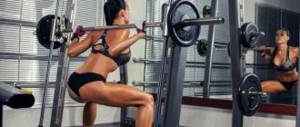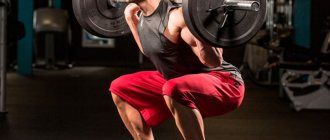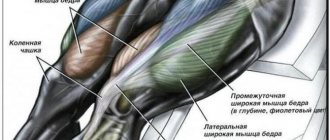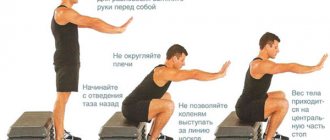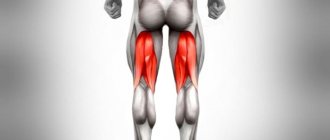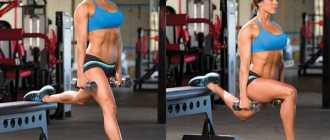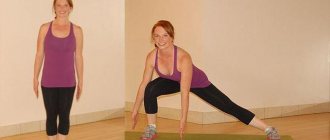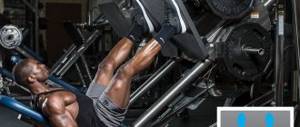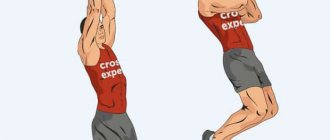Benefits and disadvantages
The exercise refers to narrowly focused techniques or variations of squats. The main purpose of performing a squat when the legs are narrow is to shift the load. In this case, the tension switches to the quadriceps (outer side). This makes this style of squats useful for creating the so-called “breeches,” which has long been an indicator of athletic fitness and physical development not only in men, but also in women. Also, such squats help improve the relief, and due to targeted pumping of the quadriceps (with a moderate diet), you can achieve pronounced separation in the hips.
The main advantages of the movement:
- Pumping the outer thighs (breeches).
- The best workout for the glutes.
- The ability to effectively work the quadriceps using lighter weights (for example, in case of problems with the spine, when excessive axial load is contraindicated).
- Improved balance and coordination.
- Development of flexibility.
- Improving the definition of the thighs.
The exercise has one drawback , and it prevents you from doing narrow squats with a barbell in a movement for constant progression (on a par with the classic squat). We are talking about increased load on the knee joints, which almost eliminates working with heavy weights for a long time. Therefore, a squat with a narrow leg position is used for a short time, in certain microcycles and no more than 6-8 weeks.
Basic mistakes when doing squats
The correct exercise technique helps to maximally work out the muscles that work when squatting and minimizes the risk of injury due to the increased load on the back and knee joints. To make the exercise as safe as possible, familiarize yourself with the main mistakes when performing it and try not to make them.
- Knees extending beyond the toes . A fairly popular mistake among beginners. The danger is that the joints are over-stressed, increasing the risk of sprains and injury. Let your knees be in line with your toes.
- Excessive relaxation of the shoulders and back . If your back automatically rounds when squatting, you need to work on it. If it is level, the spine is in a neutral position, making the exercise safe and effective. To do squats, you already know which muscles work, and work your core, you can lower your shoulder blades down a little.
- Insufficient squat depth . Many beginners are deeply afraid of squatting, because they believe that this increases the risk of knee injury. In fact, if you do everything correctly, there is no danger in this, but the effectiveness is very good. Watch how low your hips go: they should go below knee level. Then squats, which muscles are involved you know, will be as effective as possible.
- Insufficient regularity of squats . It is recommended to include squats in every workout, performing them at least 2-3 times a week. To work different muscle groups when doing squats, combine different types of them.
Let's look at how to properly perform a classic squat using your own weight . This technique involves the following nuances:
- Stand straight with your feet slightly wider than shoulder-width apart.
- Shift your weight into your heels and arches.
- Your knees should be over your ankles and your hips over your knees.
- As you move, keep your spine in a neutral position. He shouldn't overexert himself.
- You need to extend your arms in front of you and place them in a position parallel to the floor. Palms should be facing down.
- Inhale and begin to slowly move your hips back, bending your legs.
- Look forward at one point, keep your back straight, do not round it or lower your shoulders.
- As the squat deepens, focus on keeping your feet and knees in line.
- Try to go as low as you can. You can lower your hips to knee level or lower.
- Returning to the starting position, push off with your heels. This will help to engage the core muscles in the exercise.
Squats are a simple and effective exercise that allows you to work many important muscles, thereby creating an ideal body. Perform them regularly and follow safety precautions, and then the results will be amazing.
What muscles work
Narrow leg stance uses the same muscles that work during classic squats, these are:
- Quadriceps.
- Gluteal.
- Biceps femoris.
- Adductor muscles of the thigh.
- Calf.
- Soleus muscle.
If your legs are narrow to each other, then the load will mainly go to the quadriceps, especially the lateral head. The gluteus medius and minimus are also better involved in the work, but only if the squat is performed until the thigh is parallel to the floor and below.
EXERCISES
CLASSIC SQUATS
Why: training the quadriceps and thigh muscles.
How: The exercise is performed without additional weight. Everything is simple here. Keep your back straight. Clasp your hands in front of you. Squat. The shins and elbows should be in line.
Classic squats are great for beginners. This exercise will prepare you for an intense glute workout. It is not suitable for increasing muscle mass.
DEEP SQUATS
Why: load on the medius and major muscles of the thigh, quadriceps and buttocks.
How: The exercise is similar to classic squats. However, there is one difference: the pelvis should be lowered until it is parallel to the plane of the floor.
This exercise is quite difficult to perform. Ankle flexibility is key here. If this part of the body is not flexible enough, then you will not be able to squat deeply.
WITH NARROW FOOT STANDING
Why: training the medius, major and quadriceps muscles. The lumbar and abdominal muscles also work.
How to: Stand with your feet shoulder-width apart. Spread your feet slightly apart. Squat until your thighs are parallel to the floor.
If the exercise seems too difficult, place your feet a little wider or turn your toes out slightly. This way you can keep your body balanced and properly load your muscles.
SUMO SQUATS
Why: load on the large, middle and quadriceps muscles.
How to: Stand straight and spread your legs out to the sides. Turn your feet outward. Inhale and slowly squat down, keeping your back straight. At the end point, your thighs should be parallel to the floor. An important point is that the knees are in the same plane as the toes and do not connect. Move your pelvis back as far as possible. Exhale and slowly return to the starting position.
EXERCISE “CUTTESS”
Why: training the large, medius buttock and quadriceps muscles. Additional load on the hamstrings.
How to: Stand up straight, place your feet wider than shoulder-width apart, and point your toes out to the sides. During the exercise, point your knees in the same direction as your toes. Shift your weight to one leg and take a long diagonal step back with the other. One leg is in front and the toe of the foot is pointed outward. The other is behind the first. Legs crossed.
Sit down. The knee of the front leg should be parallel to the floor. With the knee of your supporting leg, reach towards the floor behind your working leg, but do not touch it. At the bottom of the squat, you should feel a stretch in the gluteal muscles of your working leg. Straighten your legs and lift your pelvis.
SQUATS WITH DUMBBELLS
Why: load on the thighs, abdominal muscles and triceps.
How: The technique for performing the exercise is the same as for classic squats. Similar muscle groups are involved.
Training with dumbbells loads the gluteal muscles and allows you to achieve the desired results faster.
SQUATS
Why: training the buttocks, thigh and back muscles.
How: The technique is the same as for dumbbell squats.
The most effective training option, however, this exercise is contraindicated for people with spinal pain.
EXERCISE “PLIE”
Why: training the femoral, gluteus medius and maximus muscles.
How to: Grab a kettlebell. Stand up straight, place your feet wider than shoulder-width apart and point your toes apart. Squat down slowly, holding the weight between your legs. At the end point, the thighs should be parallel to the floor. Return to the starting position.
Perform squats by working your buttocks, not your thigh muscles. To do this, you will have to consistently control your movements.
Barbell technique
Barbells and free weights are not the best choice for performing narrow-set squats. This is due to the fact that with this position of the legs it is much more difficult to maintain balance, especially if you want to sit quite low.
Technique:
- Remove the barbell from the supports, place the bar behind your back, on your rear delts, just below your neck.
- Place your feet at shoulder level (not close together), this is the starting position.
- Sit down with your back straight as low as possible.
- Without pausing, return to the starting position at a slightly faster pace.
It is important to ensure that the depth of the squat does not lead to rounding of the back. For a lower squat, it is recommended to additionally perform a complex of stretches, this will increase mobility and flexibility.
HOW TO DO SQUATS CORRECTLY
In order for your training to be as effective as possible, you need to follow a few simple rules when performing squats.
- Do not raise your shoulders while performing the exercise. Pull them back and keep them down.
- Keep your back straight. If you round your back, you will overload your lower back. This will lead to pain in the lumbar region.
- When squatting, move your hips back slightly. This will help put more stress on your glutes.
- Your knees should always be directly above your feet.
- Move your pelvis back as if you were sitting on an invisible chair.
- Try to squat as low as possible.
- Press your feet into the floor so that you feel balanced.
- Beginners need to control the depth of their squats. To do this, place a low stool behind your back and lower yourself until your buttocks touch it.
Inventory options
Like regular squats, “narrow” squats can be done with any equipment and machines. The Smith machine is considered the most optimal. Fixing the barbell eliminates the main problem with free weights – the possibility of losing balance, which makes the exercise completely safe. Also, with this option, some stabilizing muscles are turned off. This is very useful when it comes to focused pumping of specific muscle areas.
The Smith technique is similar to the barbell version. Moreover, in Smith you can place your feet close together without the risk of falling backwards.
The option with dumbbells is not as convenient, but it is well suited for home conditions, where there are usually no other exercise machines or equipment. Dumbbells can be “thrown” onto your shoulders, which is more like a front squat. However, this technique will help you balance your weight better and reduce the risk of falling backwards. Also, the option with dumbbells allows you to perform perhaps the deepest squat, given the location of the weight.
How to implement it into training
The narrow-foot squat is a highly specialized movement. It is not recommended to do it in the same workout as classic squats. The most convenient implementation methods are usually:
- Perform on an ongoing basis once every 2-3 weeks.
- Performing only “narrow” squats for 6-8 weeks or one training cycle.
- During a workout, it is enough to do 3-4 working approaches, especially if the last of them is failure or pre-failure.
- The repetition mode will depend on the goals and other conditions. But this type of squat works great both with a low number of repetitions (6-8) and in a high-repetition mode (12-20). Doing more than 20 repetitions is not recommended due to the stress on the knee joints.
And also read: How to do front squats with a barbell → Squats with dumbbells: technique and variations → Classic squats with a barbell →

